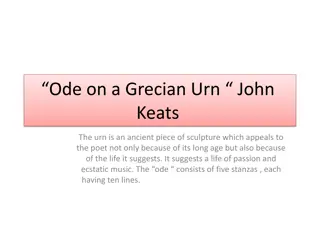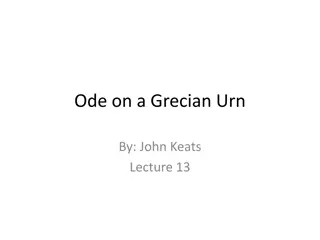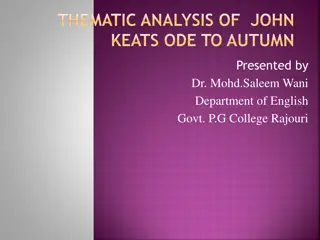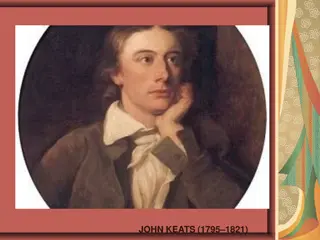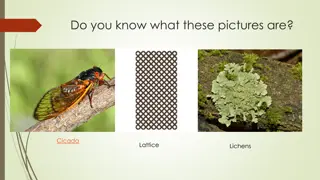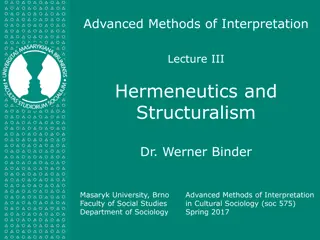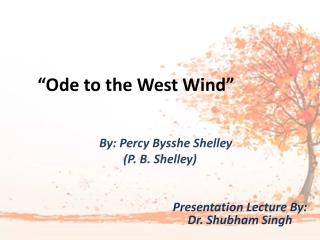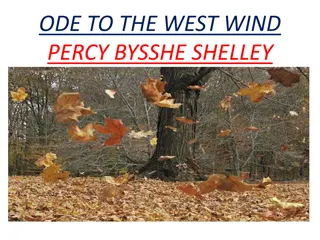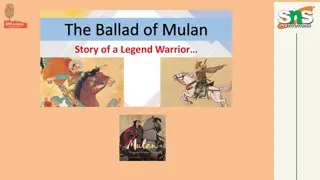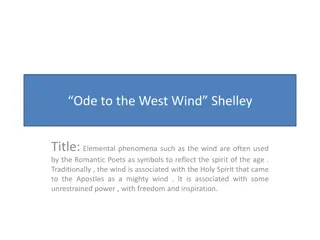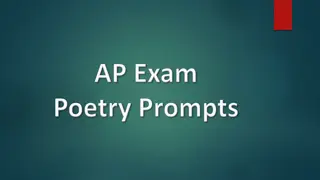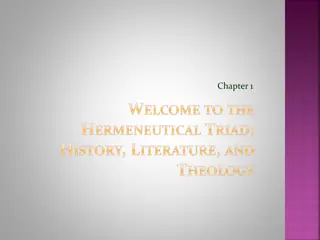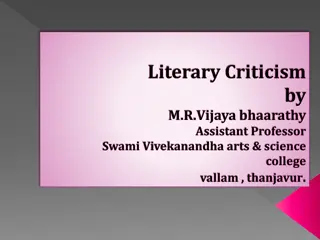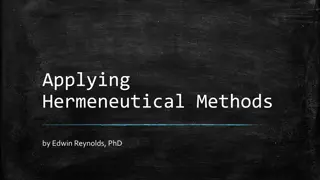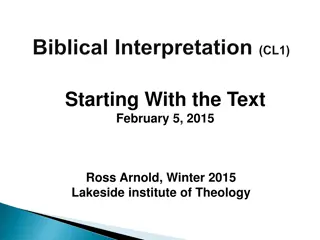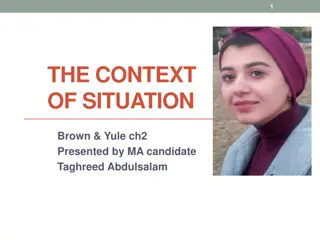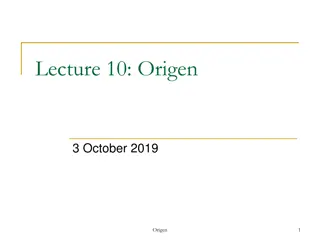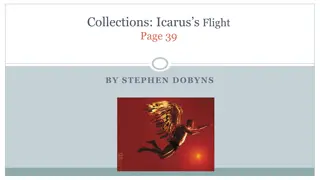Ode on a Grecian Urn by John Keats - Analysis and Interpretation
In the "Ode on a Grecian Urn" by John Keats, the poet reflects on the timeless beauty captured on an ancient urn. Through vivid imagery and lyrical language, Keats explores the themes of art, beauty, love, and immortality. The urn becomes a symbol of eternal preservation, freezing moments in time that evoke both joy and sorrow. Keats delves into the contrast between the static art depicted on the urn and the dynamic, fleeting nature of human experience. This profound meditation on art and life invites readers to ponder the complexities of existence.
Download Presentation

Please find below an Image/Link to download the presentation.
The content on the website is provided AS IS for your information and personal use only. It may not be sold, licensed, or shared on other websites without obtaining consent from the author. Download presentation by click this link. If you encounter any issues during the download, it is possible that the publisher has removed the file from their server.
E N D
Presentation Transcript
Ode on a Grecian Urn By John Keats PPT By Prof. Vaibhav Bhalerao
Thou still unravish'dbride of quietness, Thou foster-child of silence and slow time, Sylvan historian, who canst thus express A flowery tale more sweetly than our rhyme: What leaf-fring'dlegend haunts about thy shape Of deities or mortals, or of both, In Tempe or the dales of Arcady? What men or gods are these? What maidens loth? What mad pursuit? What struggle to escape? What pipes and timbrels? What wild ecstasy?
Heard melodies are sweet, but those unheard Are sweeter; therefore, ye soft pipes, play on; Not to the sensual ear, but, more endear'd, Pipe to the spirit ditties of no tone: Fair youth, beneath the trees, thou canst not leave Thy song, nor ever can those trees be bare; Bold Lover, never, never canst thou kiss, Though winning near the goal yet, do not grieve; She cannot fade, though thou hast not thy bliss, For ever wilt thou love, and she be fair!
Ah, happy, happy boughs! that cannot shed Your leaves, nor ever bid the Spring adieu; And, happy melodist, unwearied, For ever piping songs for ever new; More happy love! more happy, happy love! For ever warm and still to be enjoy'd, For ever panting, and for ever young; All breathing human passion far above, That leaves a heart high-sorrowful and cloy'd, A burning forehead, and a parching tongue.
Who are these coming to the sacrifice? To what green altar, O mysterious priest, Lead'st thou that heifer lowing at the skies, And all her silken flanks with garlands drest? What little town by river or sea shore, Or mountain-built with peaceful citadel, Is emptied of this folk, this pious morn? And, little town, thy streets for evermore Will silent be; and not a soul to tell Why thou art desolate, can e'er return.
O Attic shape! Fair attitude! with brede Of marble men and maidens overwrought, With forest branches and the trodden weed; Thou, silent form, dost tease us out of thought As doth eternity: Cold Pastoral! When old age shall this generation waste, Thou shalt remain, in midst of other woe Than ours, a friend to man, to whom thou say'st, "Beauty is truth, truth beauty, that is all Ye know on earth, and all ye need to know."
In five stanzas of ten lines each, the poet addresses an ancient Greek urn, describing and discoursing upon the images depicted on it. In particular he reflects upon two scenes, one in which a lover pursues his beloved, and another where villagers and a priest gather to perform a sacrifice. The poet concludes that the urn will say to future generations of mankind: "'Beauty is Truth, Truth Beauty.' that is all / Ye know on earth, and all ye need to know". Critics have debated whether these lines adequately perfect the conception of the poem. Critics have also focused on the role of the speaker, the power of material objects to inspire, and the paradoxical interrelation between the worldly and the ideal reality in the poem.
Like many of Keats's odes, "Ode on a Grecian Urn" discusses art and art's audience. He relied on depictions of natural music in earlier poems, and works such as "Ode to a Nightingale" appeal to auditory sensations while ignoring the visual. Keats reverses this when describing an urn within "Ode on a Grecian Urn" to focus on representational art. He previously used the image of an urn in "Ode on Indolence", depicting one with three figures representing Love, Ambition and Poesy. Of these three, Love and Poesy are integrated into "Ode on a Grecian Urn" with an emphasis on how the urn, as a human artistic construct, is capable of relating to the idea of "Truth". The images of the urn described within the poem are intended as obvious depictions of common activities: an attempt at courtship, the making of music, and a religious rite. The figures are supposed to be beautiful, and the urn itself is supposed to be realistic.[30]Although the poem does not include the subjective involvement of the narrator, the description of the urn within the poem implies a human observer that draws out these images.[31] The narrator interacts with the urn in a manner similar to how a critic would respond to the poem, which creates ambiguity in the poem's final lines: "'Beauty is truth, truth beauty,' that is all / Ye know on earth, and all ye need to know." The lack of a definite voice of the urn causes the reader to question who is really speaking these words, to whom they are speaking, and what is meant by the words, which encourages the reader to interact with the poem in an interrogative manner like the narrator.
As a symbol, an urn cannot completely represent poetry, but it does serve as one component in describing the relationship between art and humanity.[33]The nightingale of "Ode to a Nightingale" is separated from humanity and does not have human concerns. In contrast, being a piece of art, the urn requires an audience and is in an incomplete state on its own. This allows the urn to interact with humanity, to put forth a narrative, and allows for the imagination to operate. The images on the urn provoke the narrator to ask questions, and the silence of the urn reinforces the imagination's ability to operate. This interaction and use of the imagination is part of a greater tradition called ut pictura poesis the contemplation of art by a poet which serves as a meditation upon art itself.[34]In this meditation, the narrator dwells on the aesthetic and mimetic features of art. The beginning of the poem posits that the role of art is to describe a specific story about those with whom the audience is unfamiliar, and the narrator wishes to know the identity of the figures in a manner similar to "Ode on Indolence" and "Ode to Psyche". The figures on the urn within "Ode on a Grecian Urn" lack identities, but the first section ends with the narrator believing that if he knew the story, he would know their names. The second section of the poem, describing the piper and the lovers, meditates on the possibility that the role of art is not to describe specifics but universal characters, which falls under the term "Truth". The three figures would represent how Love, Beauty, and Art are unified together in an idealised world where art represents the feelings of the audience. The audience is not supposed to question the events but instead to rejoice in the happy aspects of the scene in a manner that reverses the claims about art in "Ode to a Nightingale". Similarly, the response of the narrator to the sacrifice is not compatible with the response of the narrator to the lovers.
The two contradictory responses found in the first and second scenes of "Ode on a Grecian Urn" are inadequate for completely describing art, because Keats believed that art should not provide history or ideals. Instead, both are replaced with a philosophical tone that dominates the meditation on art. The sensual aspects are replaced with an emphasis on the spiritual aspects, and the last scene describes a world contained unto itself. The relationship between the audience with the world is for benefiting or educating, but merely to emphatically connect to the scene. In the scene, the narrator contemplates where the boundaries of art lie and how much an artist can represent on an urn. The questions the narrator asks reveal a yearning to understand the scene, but the urn is too limited to allow such answers. Furthermore, the narrator is able to visualise more than what actually exists on the urn. This conclusion on art is both satisfying, in that it allows the audience to actually connect with the art, and alienating, as it does not provide the audience the benefit of instruction or narcissistic fulfilment.[36]Besides the contradictions between the various desires within the poem, there are other paradoxes that emerge as the narrator compares his world with that of the figures on the urn. In the opening line, he refers to the urn as a "bride of quietness", which serves to contrast the urn with the structure of the ode, a type of poem originally intended to be sung. Another paradox arises when the narrator describes immortals on the side of an urn meant to carry the ashes of the dead.
In terms of the actual figures upon the urn, the image of the lovers depicts the relationship of passion and beauty with art. In "Ode to a Nightingale" and "Ode on Melancholy", Keats describes how beauty is temporary. However, the figures of the urn are able to always enjoy their beauty and passion because of their artistic permanence. The urn's description as a bride invokes a possibility of consummation, which is symbolic of the urn's need for an audience. Charles Patterson, in a 1954 essay, explains that "It is erroneous to assume that here Keats is merely disparaging the bride of flesh wed to man and glorifying the bride of marble wed to quietness. He could have achieved that simple effect more deftly with some other image than the richly ambivalent unravished bride, which conveys ... a hint of disparagement: It is natural for brides to be possessed physically ... it is unnatural for them not to be."[39]John Jones, in his 1969 analysis, emphasises this sexual dimension within the poem by comparing the relationship between "the Eve Adam dreamed of and who was there when he woke up" and the "bridal urn" of "Ode on a Grecian Urn".[40]Helen Vendler expands on the idea, in her 1983 analysis of Keats's odes, when she claimed "the complex mind writing the Urn connects stillness and quietness to ravishment and a bride".[41]In the second stanza, Keats "voices the generating motive of the poem the necessary self-exhaustion and self-perpetuation of sexual appetite."[42]To Vendler, desire and longing could be the source of artistic creativity, but the urn contains two contradicting expressions of sexuality: a lover chasing after a beloved and a lover with his beloved. This contradiction reveals Keats's belief that such love in general was unattainable and that "The true opponent to the urn-experience of love is not satisfaction but extinction."[


